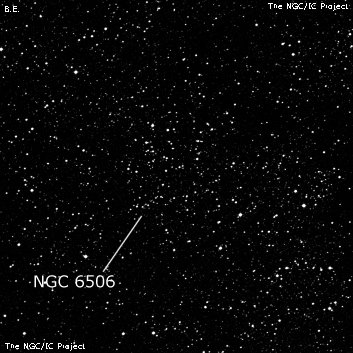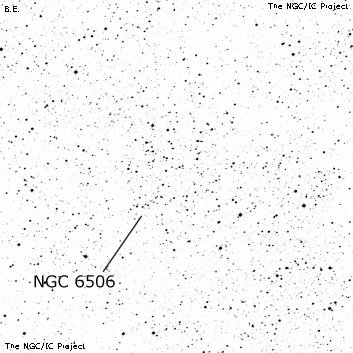NGC/IC Project Restoration Effort
(This is a very very beta version)
NGC6506


Basic Information
Location and Magnitude
Right Ascension: 17:59:53.4
Declination: -24:41:7
Constellation: SGR
Visual Magnitude:
Historic Information
Discoverer: Herschel J.
Year of discovery: 1834
Discovery aperture: 18.3
Observational
Summary description: Cl, Ri, eL, vlC
Sub-type: III2p
Corwin's Notes
=====
NGC 6506. The position in the main table applies to an apparent cluster just
southwest of JH's place. However, his description is at odds with just this
small group of stars: "A very loose but very rich cluster, which fills many
fields. Stars small." The DSS2 red image shows a star cloud about 33' x 18'
with the long axis at a position angle of 40 degrees (more or less aligned
with the Milky Way here). As with other star clouds in this part of the Milky
Way, it is defined mostly by the absorption patches surrounding it. JH's
position applies to the richest part of this cloud, and that may indeed be a
cluster. In the main table, I give positions for this "core" as well as for
the star cloud itself.
Steve's Notes
=====
NGC 6506
17.5" (8/3/97): at 100x appears as a weak, circular Milky Way enhancement of approximately two dozen mag 13-14.5 stars over an unresolved glow situated in a rich portion of the Milky Way. At 220x, this group is ~6' diameter, although it is not very well detached so the borders are somewhat arbitrary. As many as 50 stars are now visible as a number of mag 15 and fainter stars are resolved. Some unresolved background haze is still evident. Also noticed at 100x was Ru 136, a smaller circular glowing spot ~8' WSW of NGC 6506. At 220x, Ru 136 appeared ~2.5' diameter with about 10 extremely faint stars are resolved over the background glow. It is situated just NW of two mag 10-11 stars.
John Herschel's description for NGC 6506 probably applies to the entire low power Milky Way field and this object is listed as nonexistent in the RNGC.
17.5" (7/20/96): at 220x, the most noticeable grouping is a small cloud of roughly two dozen mag 13-15 stars in a 5' diameter over unresolved background haze. Situated in a fairly rich Milky Way field of mixed stars, so does not stand out.



